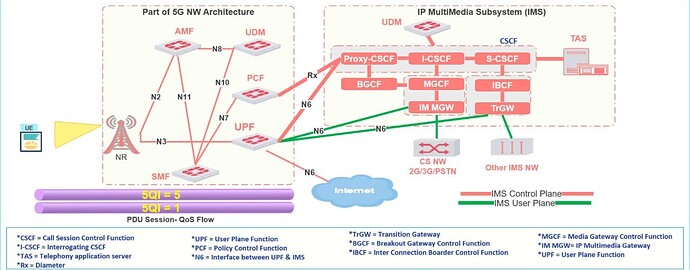-
Both VoNR and VoLTE rely upon connectivity to an IP Multimedia Subsystem (IMS) to manage the setup, maintenance, and release of voice call connections. Session Initiation Protocol (SIP) is used for signaling procedures between the UE and IMS.
-
The general network architecture for transferring the control/user plane speech packets is illustrated in the figure below. The PDU Session provides connectivity between the UE and the UPF, whereas the N6 interface provides connectivity between the UPF and the IMS.
-
VoNR uses a QoS Flow with 5QI = 5 to transfer SIP signaling messages. In contrast, VoLTE uses an EPS Bearer with QCI = 5.
Here are the main functions of IMS Entities, which are exactly the same as VoLTE:
-
The Proxy-CSCF: Acts as a first point of contact for the IMS. i.e. all SIP signaling is forwarded through the P-CSCF. Which means that all SIP messages exchanges between UE & IMS will be through P-CSCF.
-
The Interrogating-CSCF: I-CSCF is mainly responsible for identifying and selecting Serving-CSCF (S-CSCF)
-
The Serving-CSCF (S-CSCF): Responsible for processing and responding to SIP signaling messages from the UE. (Messages transfer are done through P-CSCF)
Notes:
-
P-CSCF connects to PCF/PCRF in the 5G/4G Network through the rx interface.
-
P-CSCF uses the RX interface to inform PCRF/PCF about the need for establishing a dedicated bearer for Audio Call dataflow (5QI 1).
-
PCF/PCRF then communicates with PGW/UPF then PGW/UPF triggers the establishment of a dedicated bearer for the user plane of Voice.
-
The UE request the P-CSCF address in the EPS Attach/Registration or PDN Connectivity Request messages and accordingly the UE will receive the P-CSCF Address in the PDN Connectivity accept message(Activate default EPS Bearer Request)
LinkedIn: ![]()
